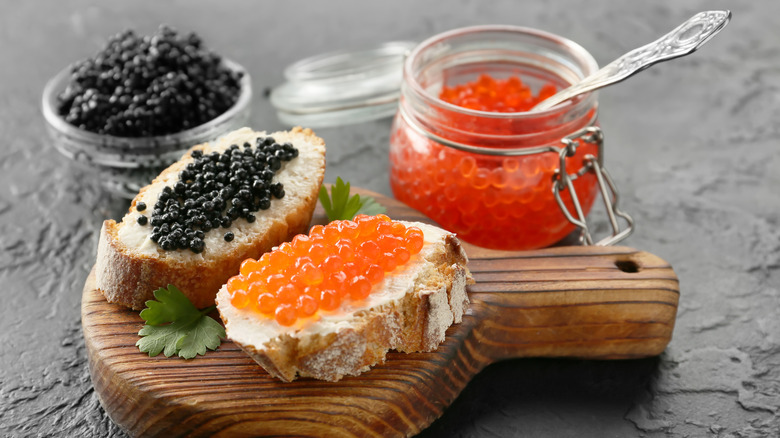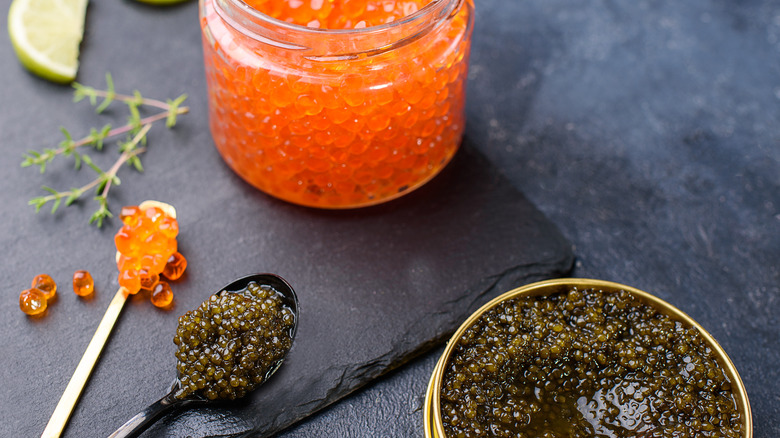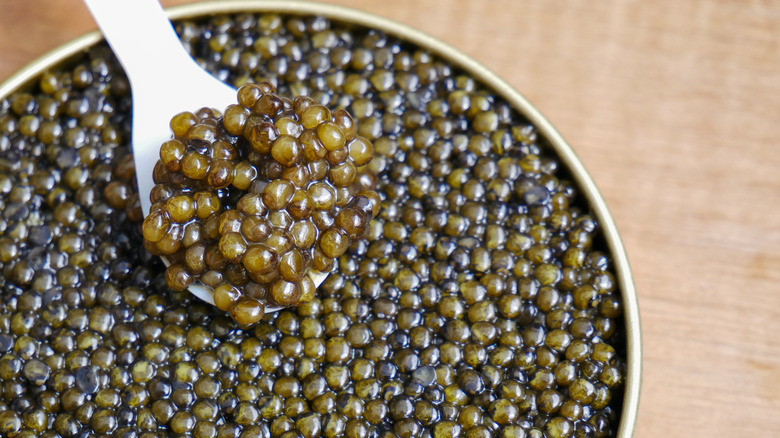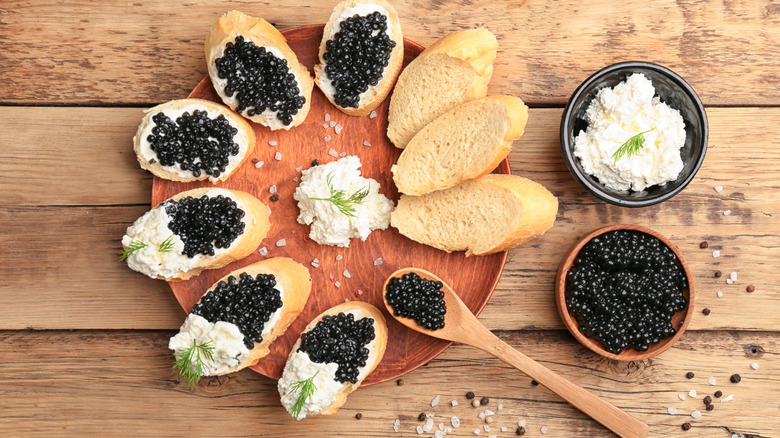The Difference Between Roe And Caviar
There is an air of prestige that fills one's mind, body, and soul when they think about luxurious items. From five-star hotels to hard-to-get ingredients and foods, there's no denying that luxury items just make everyone feel special. But with each luxury item, there will always be a counterpart that is much more attainable for a majority of people, like that of caviar and fish roe. Most folks know what caviar is but might not be as familiar with fish roe. Then there are the folks that have heard of both but just don't know the difference between the two.
According to Chowhound, roe is the term used to describe all fish eggs, while caviar only refers to the eggs from one species of fish in particular. That means that roe can come from fish like salmon, while caviar can only come from the eggs of a sturgeon. Despite its elite status among other types of roe, caviar is still considered roe as it is but a humble fish egg at the end of the day.
There are four major types of fish roe
While there are plenty of egg-laying fish in the sea (Taste Atlas notes some of the most popular), there are four major types that you will find in a restaurant. According to Medical News Today, most places will have either one of the four or a combination of a few (sometimes they will make a swap of one for the other based on price). So what are the different types?
Tobiko, masago, ikura, and caviar make up the four kinds. Tobiko is a roe that comes from the flying fish species, per Medical News Today, and is typically served at sushi restaurants elegantly added to the top of rolls or sashimi. They are a vibrant red color and top off at one millimeter from end-to-end. Masago, which comes from the smelt family, looks much like tobiko but less vibrant (the color is more reddish-brown) and is sometimes used in place of tobiko because it is cost-effective.
Ikura, which is the Japanese word for roe that comes from salmon, is the biggest in the bunch and possesses an orangey-red color. Caviar, on the other hand, only comes from sturgeon and its color can range from amber to green to a deep black (via Medical News Today). The eggs are typically small — but bigger than tobiko — and glossy. Because of its scarcity, caviar is typically the most expensive of the lot.
How caviar is harvested is partly what makes it so pricey
What most are probably unaware of is that the crème de la crème of caviar comes from the beluga sturgeon — a fish that happens to be an endangered species (via Caspian Monarque). Medical News Today notes that there are at least nine types of sturgeon caviar: beluga, kaluga, osetra, sevruga, sterlet, Siberian sturgeon, white sturgeon, hackleback, and paddlefish.
According to Insider, things like pollution, overfishing, and the destruction of their breeding grounds have left the sturgeon population in decline for some time, contributing to its prestige due to scarcity. Another added contributor to the sense of prestige is how long it takes for female sturgeons to fully mature. Insider notes that it can take a female sturgeon anywhere from eight to 20 years to reach the point of sexual maturity to bear eggs. And once those eggs are laid? The publication reports that the odds of all her eggs reaching adulthood are slim, citing that sometimes only one out of her millions of eggs will ever reach that point. With less sturgeon around, less caviar is produced driving up the overall price. As Eater explains, "entry-level" sturgeon caviar could cost between $65 to $85 for roughly an ounce, while top-tier caviar could start at $150.
Roe and caviar have a tendency of tasting a little briny
According to Mental Floss, fish eggs (both roe and caviar) normally taste somewhat briny. That being said, each egg carries a distinct flavor profile all on its own. The publication details how you can find eggs that range from savory to nutty to sweet and everything in between. Salmon roe won't taste the same as roe that comes from herring (which is said to be salty, reports Just One Cookbook).
Caviar Star further details that despite there being so many different kinds of fish roe, the taste of caviar substitutes doesn't compare to the flavors that you can find with the different types of sturgeon caviar. For example, Osetra is said to have buttery notes, while Siberian sturgeon has a pronounced briny flavor to it. Caviar Star also notes that things like red caviar and tobikko have a fishier taste when compared to their other egg counterparts. Regardless of the one you choose, you're going to be in for one deliciously crunchy bite.



